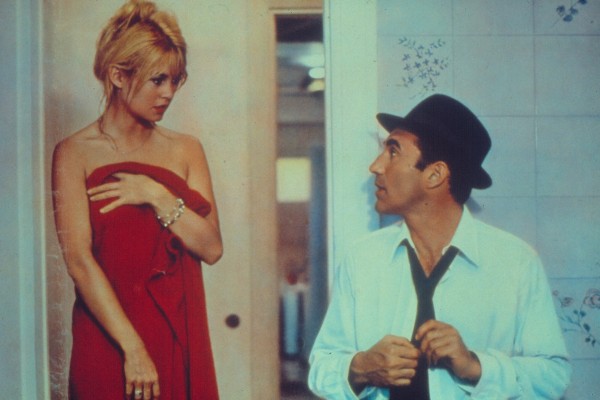
A major season dedicated to one of the godfather’s of the French New Wave, Jean-Luc Godard, is coming up at the BFI from January – March 2016. The season will feature over 100 examples of his vast and varied output, including feature films, short films, self-portraits, experimental TV productions and a number of rarities.
So expect an extended run of LE MÉPRIS from 1 January – introduced by his former wife Anna Karina on 16th January. She will also be there to chat to audiences about her role in VIVRE SA VIE (1962) and BANDE À PART (1964), both on extended run at the Southbank main screen.
LE MÉPRIS | Cast: Brigitte Bardot, Michel Piccoli, Jack Palance, Georgia Moll, Fritz Lang, Jean-Luc Godard | France/Italy 1963, 103 min.
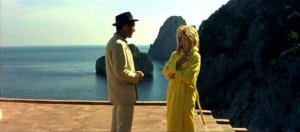 For JL Godard LE MÉPRIS was just ”a film without mystery, an Aristotelian film, freed from appearances [it] proves, in 149 shots, that in the cinema, just as in real life, there is nothing secret…there is nothing to do but live – and film”. His producers, among them Carlo Ponti and Joseph E. Levine, must have been quiet shocked by the austere outcome, they insisted on an additional scene, showing the physical beauty of its star, Brigitte Bardot, only to be outmanoeuvred by the director.
For JL Godard LE MÉPRIS was just ”a film without mystery, an Aristotelian film, freed from appearances [it] proves, in 149 shots, that in the cinema, just as in real life, there is nothing secret…there is nothing to do but live – and film”. His producers, among them Carlo Ponti and Joseph E. Levine, must have been quiet shocked by the austere outcome, they insisted on an additional scene, showing the physical beauty of its star, Brigitte Bardot, only to be outmanoeuvred by the director.
Based on Alberto Moravia’s novel “Il Disprezzo’ (The Ghost at Noon), this film about filmmaking starts with the basics: a dolly on rails follows Georgia Moll’s Francesca Vanini who walks towards the camera, whilst the opening credits are not only shown, but also read out loud. A Bazin quote reminds us, that “film substitutes a world that conforms our desires”. “The follow-up scene of Bardot’s Camille, laying naked on her belly, and her husband Paul (Piccoli), was supposed to entice a mass audience and was shot after the film was finished. But Godard simply subverted the call for any form of eroticism, letting Camille ask Paul which parts of her anatomy he loves the most – the obvious answer is everything – whilst she lies unmoved and statuesque during the long enumeration. Strangely, these are the only happy moments Camille and Paul will have during the whole film. When Paul, a scriptwriter, later meets the American producer Prokosh (Palance) in Rome’s Cinecitta, Camille feels that her husband is pimping her out to the arrogant, misogynist and dictatorial producer who exclaims: “I like Gods, I know exactly how they feel”. In addition, he is treating his well-educated assistant and translator Francesca Vanini (Moll) like a slave girl.
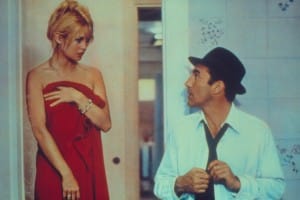 Whilst sitting in a preview theatre with Fritz Lang – as himself, the director of Homer’s ‘Odyssey’, the film being produced, Paul and Camille witness a terrible strop by Prokosh, who, unhappy about the rushes shot by Lang, kicks the film rolls around the room and then has Vanini bent over, to write a check for Paul on her back changing the script into a more populist version. Shouting “When the Nazis heard the word culture, they drew a revolver; I am only writing a check”, Prokosh gives Paul the check: the 10 000 Dollar are supposed to pay the mortgage for Camille’s and Paul’s flat in Rome. When Paul accepts the check, however reluctant, he looses his wife.
Whilst sitting in a preview theatre with Fritz Lang – as himself, the director of Homer’s ‘Odyssey’, the film being produced, Paul and Camille witness a terrible strop by Prokosh, who, unhappy about the rushes shot by Lang, kicks the film rolls around the room and then has Vanini bent over, to write a check for Paul on her back changing the script into a more populist version. Shouting “When the Nazis heard the word culture, they drew a revolver; I am only writing a check”, Prokosh gives Paul the check: the 10 000 Dollar are supposed to pay the mortgage for Camille’s and Paul’s flat in Rome. When Paul accepts the check, however reluctant, he looses his wife.
In a breath-taking 34 minute sequence in the couple’s flat, Godard follows the unravelling of their relationship with tracking shots which show the growing distance between the couple. These finally unravels in one frame in two different rooms, divided by a wall. Camille is slapped by Paul, she slaps back, he retreats, but it is too late: Camille shouts angrily: “When you were writing crime novels, we were broke, but that was fine with me”.
The flat, which was to cement their relationship, has become the albatross killing their love. Paul still believes he can save his marriage and seems to have learned nothing: when the film crew moves on to Capri, Paul again leaves Camille, against her will, alone with Prokosh, who obviously fancies her. This time Camille retaliates: she kisses the producer in full sight of Paul. Then she packs her bags to leave for Rome, whilst Paul terminates his contract with Prokosh. To humiliate Paul even further, Camille lets Prokosh, whom she despises, drive her to Rome. Their journey ends in a fatal crash, which is not shown, Godard making fun of mainstream movies, just showing the dead bodies in grotesque positions, with the last words of Camille’s good-bye letter to Paul superimposed: “Take Care. Adieu. Camille”.
LE MÉPRIS ends with serene filmmaking in Capri, where Godard acts as Lang’s assistant in shooting the scene when Odysseus returns to Ithaca. As Godard pointed out “the film is shot entirely in real locations, both exteriors and interiors, honest and authentic”. One of them is the gorgeous villa of the Italian author Curzio Malaparte on Capri, designed by Alberto Libera: it lays like a space ship in the sun, in the panorama shots, the film crew with their equipment look like aliens at work. Movie posters of Hitchcock’s Psycho and Nicholas Ray’s Bigger than Life among others, decorate Paul and Camille’s flat; but the main honour goes to Roberto Rossellini: Apart from the poster of his 1961 film Vanina Vanini (sic!), the group visits a cinema to hear a performance of a singer. We notice that Paul and Camille are sitting on the edge of their respective aisles, and after they all leave the cinema, we see Rossellini’s Viaggio in Italia advertised in big letters on the cinema front.
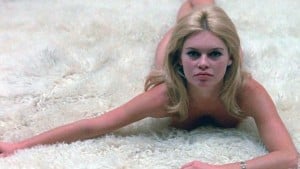 Raoul Coutard’s scope camera produces three different sets of colours: in the opening sequence of the couple in bed, soft, warm colours dominate. Then everything changes to cold, icy mages. Lang’s film takes, which he shoots as an actor, are dominated by classic colours, appropriate to the content of the film. Godard employed no less than five future directors for the project: Suzanne Schiffman (Script Supervisor), Charles L. Bitsch (Assistant director), Bertrand Tavernier (Publicity), Luc Moulett, whose book on Fritz Lang Camille reads in the bath and Jacques Rozier, who shot a documentary about the making of LE MÉPRIS.
Raoul Coutard’s scope camera produces three different sets of colours: in the opening sequence of the couple in bed, soft, warm colours dominate. Then everything changes to cold, icy mages. Lang’s film takes, which he shoots as an actor, are dominated by classic colours, appropriate to the content of the film. Godard employed no less than five future directors for the project: Suzanne Schiffman (Script Supervisor), Charles L. Bitsch (Assistant director), Bertrand Tavernier (Publicity), Luc Moulett, whose book on Fritz Lang Camille reads in the bath and Jacques Rozier, who shot a documentary about the making of LE MÉPRIS.
But there is also a very personal moment in Godard’s LE MÉPRIS: Camille buys herself a black wig making her look just like Anna Karina (Godard’s first choice to play Camille) two years later as Natacha von Braun in the car with Eddie Constantine’s Lemmy Caution at the end of Alphaville: only then it was the begin of a love story, this is the end. George Delerue’s mourning main tune, which accompanies not only this scene, is the haunting voice in this story of money versus art, which ends in the loss of love.
Le Mepris is prove, that Jean-Luc Godard, even though he ended sometimes in a cul-de-sac whilst re-inventing the cinema, is still the most important director of the second half of the 20th century. AS
BANDE À PART Cast: Anna Karina, Sami Frey, Claude Brasseur, Louisa Colpeyn | 95 min | Drama | France
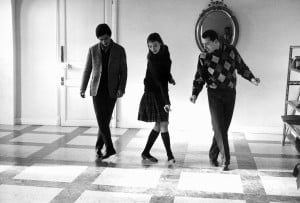 BANDE À PART, shot in 25 days and based on the pulp novel “Fool’s Gold” by Dolores Hitchins, was project that Godard embarked on to support his marriage with Anna Karina. The pair hadn’t worked together since Vivre sa vie. Godard called his production company “Anouchka”, his pet name for Karina, and he gave the character she played Odile, after his late mother.
BANDE À PART, shot in 25 days and based on the pulp novel “Fool’s Gold” by Dolores Hitchins, was project that Godard embarked on to support his marriage with Anna Karina. The pair hadn’t worked together since Vivre sa vie. Godard called his production company “Anouchka”, his pet name for Karina, and he gave the character she played Odile, after his late mother.
At an English language school in Paris, two petty swindlers, Franz (Frey) and Arthur (Brasseur) fall in love with Odile (Karina). Arthur lives with the enigmatic Madame Victoria (Colpeyn) in the suburbs, where a mostly absent Mr. Stolz has a huge amount of cash hidden in his cupboard. Franz and Arthur want nothing more than to bed with Odile – apart from stealing the money. Their clumsy plan backfires, they kill Madame Victoria, and while Franz and Odile escape to South America to start a new life, Arthur and his uncle kill each other in Madame Victoria’s garden before the money, now hidden in a dog’s kennel, is stolen by surprise.
Godard had run out of producers and had asked Columbia, Paramount and UA to give him 100.000 $ to make a picture. All questioned the high figure Godard was asking for and when he explained that this was for the whole production, only Columbia agreed to take him up on the project. Godard gave them a choice of three topics: the first about a woman leftie, the second about a writer and the final topic about the Hitchins crime novel: they obviously picked the latter. With such a small budget,, the studio did not even bother about a script.
The director’s poetic voice-over re-tells the story from the emotional point of view of the three main protagonists, in a narrative full of quotations, references and in-jokes. But instead of being all-knowing, the voice-over soon loses the plot – the characters are coming into their own. It gives the impression that Godard was filming in perpetual motion. Everything and everybody moves in silence: in a scene at the ‘Café Madison’, there is no sound for a minute, followed by the now famous dance scene of the trio, a polonaise copied by many, amongst them Hal Hartley and Quentin Tarantino. The film is symbolised by the three of them racing through the Louvre. The images are rush by: money, pistols, death, Odile’s stockings as masks, Shakespeare and always the leafless trees, set against a dark November sky. Raoul Coutard’s images literally shot on the run, like he had done during the Indochina war.
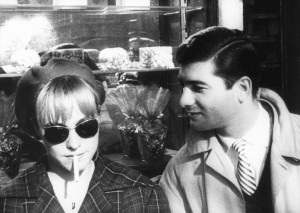 Again, Godard was in opposition to everything – even though the film turned out to be very much a neo-classical in style: “This movie was made as a reaction against anything that wasn’t done. It was almost pathological and systematic. A wide-angle lens is not normally used for close-ups? Then let’s use it. A handheld camera isn’t normally used for tracking shots? Then let’s try it. It went along with my desire to show that nothing was off limits.” For once, film and reality coincided: during the shooting, Karina and Godard got back together again, moving into a new apartment in the Latin Quarter, Karina admitting “It’s true: the film saved my life. I had no more desire to live. I was doing very, very badly. This film saved my life”.
Again, Godard was in opposition to everything – even though the film turned out to be very much a neo-classical in style: “This movie was made as a reaction against anything that wasn’t done. It was almost pathological and systematic. A wide-angle lens is not normally used for close-ups? Then let’s use it. A handheld camera isn’t normally used for tracking shots? Then let’s try it. It went along with my desire to show that nothing was off limits.” For once, film and reality coincided: during the shooting, Karina and Godard got back together again, moving into a new apartment in the Latin Quarter, Karina admitting “It’s true: the film saved my life. I had no more desire to live. I was doing very, very badly. This film saved my life”.
Watching Bande À Part the for the first time in 1965, as first year students – we all admired the sequences when the actors read colportage stories from newspapers – we thought that it was vey cool. According to Raoul Coutard “there was no real script. Jean-Luc would show up with whatever he had written for the day. We’ve end up filming that. If he hadn’t written anything, we would not have filmed anything.” The newspaper stories, as it turned out, were just paddings, when the master had not written enough…. AS
VIVRE SA VIE | Cast: Anna Karina, Sady Rebbot, Andre S. Labarthe, Brice Parain; France 1962, 85 min. *****
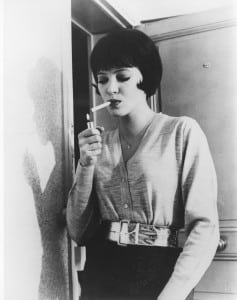 VIVRE SA VIE marked a decisive step in the development of film aesthetics – born out of the emotional turmoil between Jean Luc Godard and the leading star, Anna Karina, whose marriage had been very much on the rocks when the cameras started to roll in February 1962 in Paris.
VIVRE SA VIE marked a decisive step in the development of film aesthetics – born out of the emotional turmoil between Jean Luc Godard and the leading star, Anna Karina, whose marriage had been very much on the rocks when the cameras started to roll in February 1962 in Paris.
Karina was ten years younger than Godard. She had met the actor Jacques Perrin whilst filming Le Soleil dans l’Oeil on Corsica in September 1961, while celebrating her 21st birthday. During the shooting, Karina decided to leave her husband for Perrin: “I admire Jean-Luc very much. But he’s of another generation. Whereas Jacques is my double”.
On the night of November 21st, Godard destroyed all their belongings in the flat they shared and walked out. Karina, who reportedly had taken barbiturates, was taken to hospital. Godard and Perrin met for a duel with dice, then settled for poker, but when journalists crowded their table, nothing was decided. Whilst the papers reported over the Christmas period that Karina would marry Perrin, Godard and Karina had reconciled by January 1962 and Godard announced he would direct her in Vivre Sa Vie – without a fee – as they were living together.
Godard was a great admirer of Berthold Brecht (Cahiers had run a special edition dedicated to him), and Vivre Sa Vie was to be a tableau of 13 chapters, with the master of ceremony introducing every one. Godard, obviously having Brecht’s ‘Three Penny Opera’ in mind” wanted “to shoot only on location, but without making a film of reportage”. But the director abandoned not only the master of ceremony idea (replaced by inserts about the chapter contents), but also changed the ending: instead of a sardonic ending – Nana becoming a rich luxury prostitute -, she is killed at the end of chapter 12, now the last one. Needless to say, that Karina was furious and the shoot was stopped for a few days.
 Nana (easily deciphered as an anagram of Anna) leaves her husband Paul (Labarthe) and child with the words: “I want to die”. She has dreamt for a long time of becoming a film star, and tells everyone that she has acted in a film with Eddie Constantine. (Karina, Godard and Constantine acted un-credited in Varda’s Cleo). She shouts at Paul: “If we get back together, I will betray you again.” Nana, who works in a record shop, is always broke, she can’t pay her rent and is humiliated by the concierge and her assistant. She slips into prostitution, first as an amateur, then, after meeting the pimp Raoul (Rebbot), as a professional. Her lonely and dreary existence is heart-breaking; waiting in street for a customer in Port Mailliot she is standing under the company sign: Hans-Lucas (Jean-Luc in translation). After meeting a young artist, she falls in love and wants to start a new life, but she is literally sold by Raoul to another pimp in a street.
Nana (easily deciphered as an anagram of Anna) leaves her husband Paul (Labarthe) and child with the words: “I want to die”. She has dreamt for a long time of becoming a film star, and tells everyone that she has acted in a film with Eddie Constantine. (Karina, Godard and Constantine acted un-credited in Varda’s Cleo). She shouts at Paul: “If we get back together, I will betray you again.” Nana, who works in a record shop, is always broke, she can’t pay her rent and is humiliated by the concierge and her assistant. She slips into prostitution, first as an amateur, then, after meeting the pimp Raoul (Rebbot), as a professional. Her lonely and dreary existence is heart-breaking; waiting in street for a customer in Port Mailliot she is standing under the company sign: Hans-Lucas (Jean-Luc in translation). After meeting a young artist, she falls in love and wants to start a new life, but she is literally sold by Raoul to another pimp in a street.
Raoul Coutard’s triste black and white images achieve, in long takes, what Godard had in mind: “I was thinking – like a painter in a way, confronting my characters head-on – as in the paintings of Matisse or Braque”. Godard seems to circle his environment, like a researcher, but he always returns to Karina: from the back, the front, the side and even in parts. She is his universe, but he can’t decipher her. Still, striving to understand her seems to make him happy. In an experiment in language, Nana is trying to intonate a sentence in different ways; Godard shows, that there is no absolute truth in our words, and he always returns to her vulnerable face with the Louise Brooks haircut.
VIVRE SA VIE won the Special Jury Price and the Critic’s Prize at the Venice Film Festival in 1962. AS
SCREENING DURING THE GODARD SEASON AT THE BFI FROM JANUARY – MARCH 2016